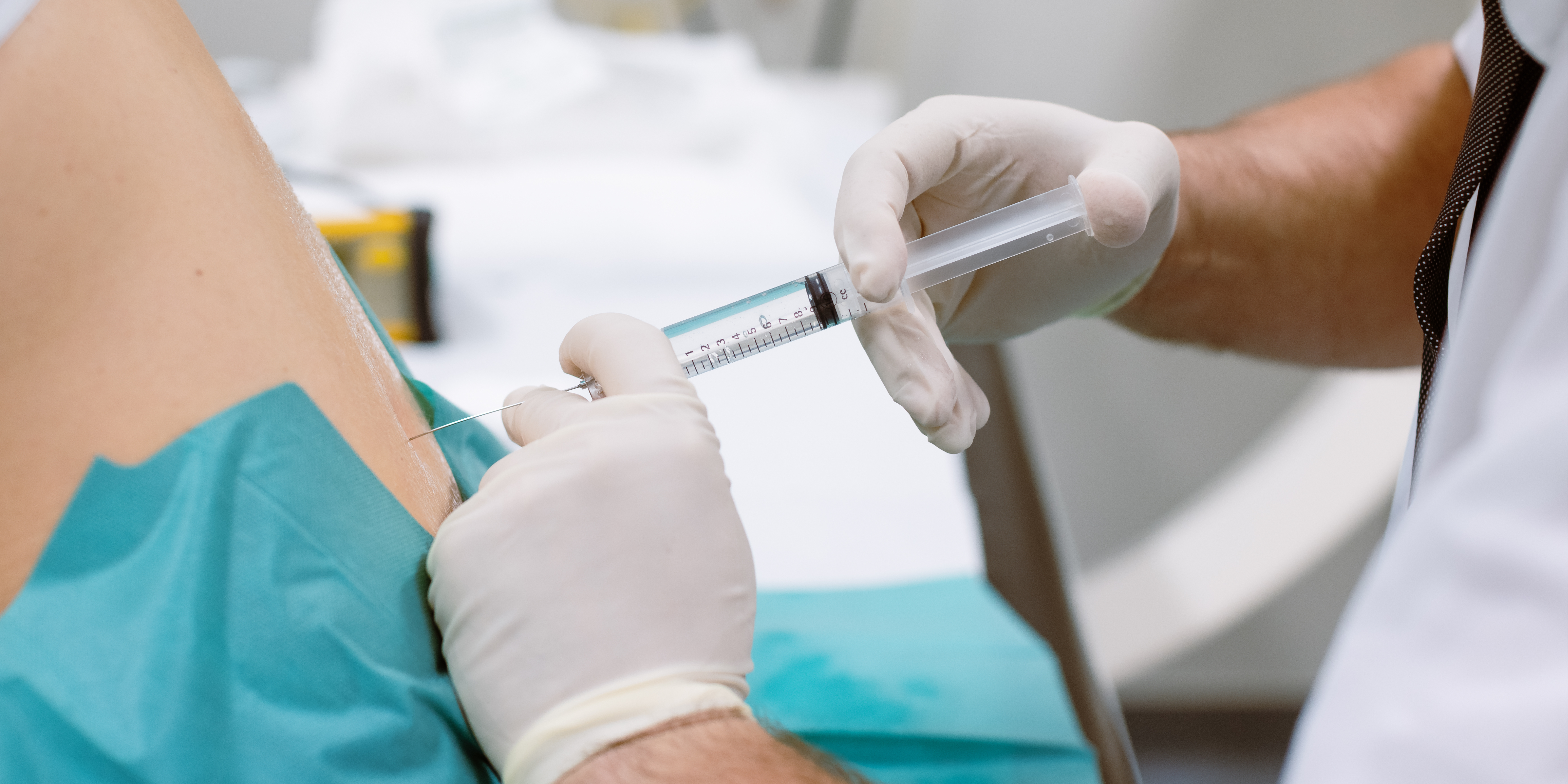
Effective Treatment for Inflammation and Pain
Cortisone injections are a safe and effective pain relief treatment for many orthopedic problems, including tendonitis, arthritis, and bursitis. As an anti-inflammatory medication, cortisone works by preventing collagen production in the joints, providing immediate relief from pain that can last for several months. Our physicians, led by Dr. Raj Raval, MD, offer comprehensive, personalized, and time-tested treatment plans that focus on your specific level of pain.
What is a Cortisone Injection?
Cortisone injections are used to treat inflammation and reduce pain in various parts of the body. Since the discovery of cortisone’s anti-inflammatory properties in 1951, it has become a common form of treatment. Unlike painkillers, cortisone is an anti-inflammatory medication that reduces pain by addressing inflammation. Cortisone, a synthetic version of cortisol, is a steroid produced in the adrenal gland and released in response to stress.
How Do Cortisone Injections Work?
Cortisone is injected directly into the site of inflammation. While it is often used to treat pain, cortisone itself is not a pain medication but an anti-inflammatory that prevents collagen production in the joints. By reducing inflammation, cortisone indirectly reduces pain. Patients may experience relief either gradually over a period of days or weeks or immediately after the injection.
Benefits of Cortisone Injections
Cortisone injections offer quick relief for inflammation and pain. They are effective and quick-acting, making them a common short-term treatment to manage flare-ups of inflammatory conditions. Cortisone injections are used for various conditions, including:
- Rheumatoid arthritis
- Allergic reactions
- Asthma
- Frozen shoulder
- Osteoarthritis
- Gout
Potential Side Effects and Complications
Cortisone injections are generally safe, but they can cause side effects and complications in rare cases. Some patients may experience a cortisone flare, which is severe pain that lasts for 24 to 48 hours. Other potential side effects include:
- Injury from the injection
- Crystallization of cortisone
- Infection (very rare)
Most side effects are mild and temporary. In case of severe or prolonged pain, consult your healthcare provider.
Frequently Asked Questions
What causes pain after a cortisone injection?
Pain following a cortisone injection is considered to be caused by the injection itself if it’s worse than the pain that was there before. It can be due to injury from the injection, crystallization of cortisone, or infection.
How can pain after a cortisone injection be managed?
NSAIDs are usually recommended for cortisone flares to reduce inflammation. Resting the affected area and using cold compresses can also help relieve pain.
Are cortisone injections safe?
Yes, cortisone injections are safe and rarely have adverse side effects. However, it is important to follow all recommended steps, such as getting an X-ray or MRI scan, to ensure the underlying cause of pain is inflammation.
How long does pain relief from a cortisone injection last?
Pain relief from a cortisone injection can last for several months, depending on the individual and the condition being treated.
What should I do if the pain persists?
If the pain persists despite conservative measures, consult your healthcare provider.
Schedule an Appointment
If you have any questions about cortisone injection treatment for your pain or would like to schedule an appointment with our top-rated pain specialists, please call our office for a consultation. Our pain centers are located in Downtown Brooklyn and Lower Manhattan.

Effective Pain Relief for Arthritis
Arthritis can cause intense pain and be debilitating, but with appropriate pain management and treatment, the pain doesn’t have to be all-consuming. Downtown Pain Physicians, New York, NY’s premier pain management practice, offers innovative treatments designed to provide lasting pain relief, including viscosupplementation injections for osteoarthritis.
What is Osteoarthritis (OA)?
Osteoarthritis (OA) is a chronic joint condition affecting over 30 million people in the United States. It results from joint damage that occurs over time, causing the cartilage to break down. This leads to pain, inflammation, stiffness, and tenderness as bones start to rub directly against each other. OA commonly affects joints such as the knees, spine, lower back, hips, hands, and fingertips.
What is Viscosupplementation?
Viscosupplementation injections, also known as gel shots, involve injecting hyaluronic acid into arthritic joints to reduce pain and improve movement. This treatment is often considered when other treatments, such as over-the-counter medications and corticosteroid injections, have not provided sufficient relief.
Who is a Candidate for Viscosupplementation?
Viscosupplementation is typically for patients with mild to moderate osteoarthritis, particularly of the knee. It is not suitable for individuals with allergies to hyaluronate products, pregnant or nursing women, children or adolescents, and those with infections in the injection area.
The Procedure and What to Expect
Preparation:
- Minimal preparation is required.
- You can eat and drink normally on the day of the appointment.
- Inform the doctor of any new symptoms or infections.
Procedure:
- The patient lies down or sits with the knee in a preferred position for the injection.
- The area is cleaned, and a local anesthetic is applied.
- The doctor may remove excess fluid from the knee if swollen.
- Using ultrasound for guidance, the gel shot is injected into the knee joint.
- The site is cleaned and bandaged, and the patient is asked to move the knee to spread the medication.
Post-Procedure Care:
- Avoid heavy activities for 12 to 24 hours.
- Engage in low-impact activities like slow walks.
- Results typically start appearing 3 to 4 weeks after the first injection.
- Physical therapy and exercises may be recommended to maintain and increase muscle strength around the knee joint.
Comparing Gel Shots to Corticosteroids
Steroid injections provide immediate pain relief but come with risks such as increased blood sugar and potential adverse effects with long-term use. Gel shots, or viscosupplementation, offer a more natural solution with fewer risks by acting as a substitute for synovial fluid, improving joint lubrication and movement.
Benefits and Effectiveness
- Long-lasting Relief: Patients often experience pain relief within 3 to 5 weeks, with effects lasting up to 6 months.
- Minimal Risks: Common side effects include temporary pain, swelling, or redness at the injection site. More serious complications are rare.
- Combination Therapy: Viscosupplementation can be used alongside other treatments like physical therapy and medications.
Research and Statistics
Studies have shown viscosupplementation to effectively reduce symptoms of OA and delay the need for knee replacement surgery. In one study, 71% of participants reported effective treatment a year after receiving viscosupplementation.
Frequently Asked Questions
When Will I Experience Pain Relief?
Pain relief typically begins within the 3 to 5-week window and continues to improve over the next 8 to 12 weeks.
How Effective are Viscosupplementation Injections?
Effective for patients with mild to moderate OA, providing significant pain relief that can last up to 6 months.
What are the Risks?
Common side effects include temporary pain, swelling, and redness at the injection site. Rare risks include infection and allergic reactions.
What Happens After the Injection?
You can go home the same day. Avoid excessive walking, lifting heavy weights, or standing for long periods for 48 hours.
What if the Injections Don’t Work?
Other treatment options include steroid injections, comprehensive treatment plans with physical therapy, and potentially joint surgery.
Living with OA and Finding Relief
Managing OA is a daily struggle, but viscosupplementation offers a non-invasive procedure that provides proven pain relief for many patients. This treatment can be part of a comprehensive approach, including physical therapy, medications, and other therapies.
Meet Dr. Tanuj Palvia, MD – Board Certified in Pain Management and Anesthesiology

Dr. Sarah Rodriguez, DPT
Doctor of Physical Therapy